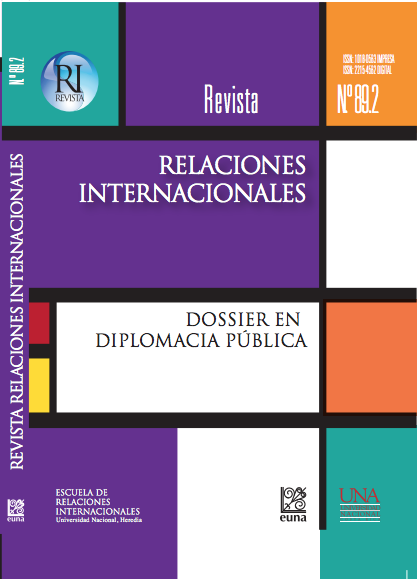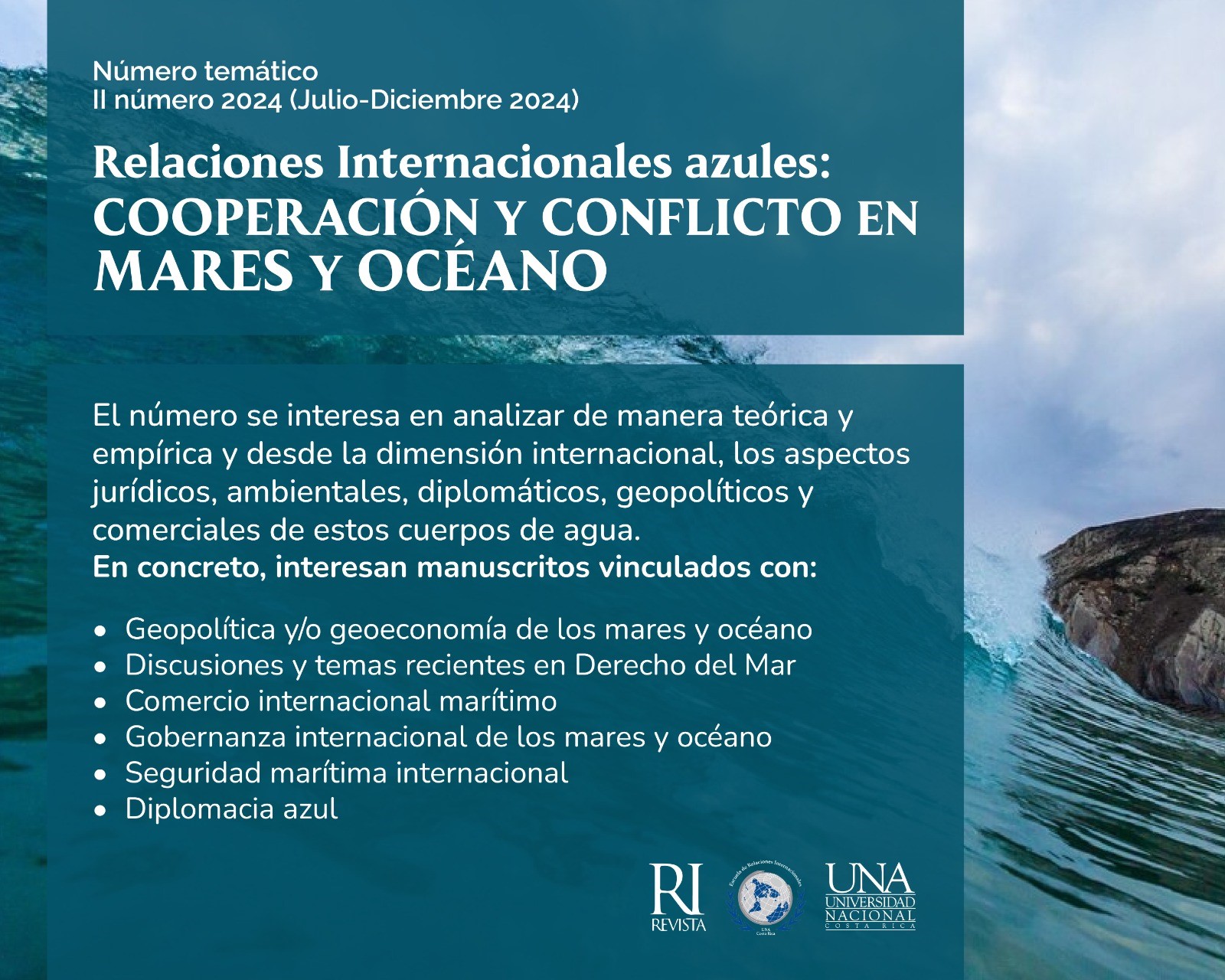Brasil's geopolitical lever in the shaping of the South American regional and global politics
DOI:
https://doi.org/10.15359/ri.89-2.8Palabras clave:
BRICS, Brasil, América del Sur, Liderazgo regional, globalResumen
Los estados BRICS (Brasil, Rusia, India, China y Suráfrica) como potencias emergentes se han posicionado como los actores internacionales que lideran regionalmente y conjuntamente están retando al liderazgo unilateral del planeta. Este artículo argumenta que el prospecto de ser un estado de los BRICS corrobora a cada nación para proyectarse como un world political player. Pero, esto puede torpedear la proyección de posesionarse como líder regional como en el caso brasilero en la región suramericana. Otros factores como la influencia de las economías, aspectos políticos y militares extra-regionales podrían contribuir en el decline y posiblemente en el constreñimiento de la consolidación de Brasil como líder de la región. Para ilustrar esta propuesta este artículo hace uso del modelo geopolítico de Modelski que ayuda a explicar la emergencia y caída de potencias mundiales. La propuesta de este modelo está combinado con elementos de la teoría de posicionamiento, Positioning Theory. La evidencia está compuesta de un conjunto de datos cualitativos y se emplea análisis cualitativo de contenido para la interpretación de la dataReferencias
Andrade, M., (2001). Geopolítica do Brasil, São Paulo: Papirus.
Álvarez Valdés, R., (2009). UNASUR; desde la perspectiva subregional a la regional: FLACSO, Serie Documentos Electrónicos 6, 1-11.
Armijo, L., (2007). The BRIC Countries (Brazil, Russia, India, and China) as Analytical Category: Mirage or Insight? Asian Perspective, 31 (4), 7-42.
Armijo, L. and Sotero, P., (2007). Brazil: To be or not to be a BRIC? Asian Perspective, 31 (4), 43-70.
Arvin, R., (2010). World Turned Upside Down? Rise of the Global South and the contemporary global financial turbulence. Third World Quarterly, 31 (3), 365-384. Doi: https://doi.org/10.1080/01436597.2010.488465
Ascanio, A., (2010) Análisis del Discurso Político. México: Trillas.
BRICS Information Centre, (2016). What is new in the BRICS? University of Toronto. http://www.brics.utoronto.ca/ accessed 20.06.2016.
Câmara Dos Deputados (2010) Constitution of the Federative Republic of Brazil. 3rd Edition. Biblioteca Digital da Câmara Dos Deputados.
Cardoso, E. and Holland, M., (2010). South America for the Chinese? A trade-based Analysis. OECD. Doi: https://doi.org/10.1787/5kmh5gs82q0v-en
Cassiolato, J. and Vitorino, V., (2009). BRICS and Development Alternatives: Innovation Systems and Policies. London: Anthem Press.
Chiriboga Vega, M., (2009). ¿Es la CAN un sistema vigente de integración? Quito: Friedrich Ebert Stiftung.
Comisión Económica para América Latina (CEPAL), (2010). Estudio económico de América Latina y el Caribe. Santiago de Chile: Naciones Unidas.
Couto e Silva, G., (1967). Geopolítica do Brasil. Rio de Janeiro: Olimpyo
Couto e Silva, G., (1981). Planejamento Estratégico. Rio de Janeiro: Universidad de Brasilia.
Crane, R., (2015). Building Bridges among the BRICs. Edited by Robert Crane Independent Consultant, Paris, France. Palgrave Macmillan. Doi: https://doi.org/10.1057/9781137375414
Dailami, M. and Masson, P., (2009). The New Multi-polar International Monetary system. The World Bank. Policy Research Working Paper. 5147. Doi: https://doi.org/10.1596/1813-9450-5147
Deciancio, M., (2016). Brazil’s Leadership through Global Channels: Autonomy, Diversification and Acceptance. In Global and Regional Leadership of BRICS Countries, Stephen Kingah y Cintia Quiliconi. New York: Springer. Doi: https://doi.org/10.1007/978-3-319-22972-0_4
Derluguian, G, Goldfrank, W., (2000). Repetition, Variation and Transmutation as Scenarios for the Twenty First Century. In Questioning Geopolitics. Derluguian, G. and Greer, L. Connecticut: Praeger.
Duggan, N., (2015). BRICS and the Evolution of a New Agenda within Global Governance. In The European Union and the BRICS Complex Relations in the Era of Global Governance. Marek Revizorski. New York: Springer. Doi: https://doi.org/10.1007/978-3-319-19099-0_2
Elsenhans, H., (1998). Imperialismus/Imperialismus Theorie. In Wӧrterbuch Staat und Politik Dieter Nohlen. Bonn: Bundeszentrale für politische Bildung.
Flint, C., (2006). Introduction to Geopolitics. London: Routledge.
Goh, E., (2008). Great Powers and Hierarchical Order in Southeast Asia Analysing Regional Security Strategies. International Security, 32 (3), 113-157. Doi: https://doi.org/10.1162/isec.2008.32.3.113
Heinrich Böll Stiftung. (2014). BRICS Summit Reader. Special E-Newsletter. 20: July 2014.
Heisbourg, F., (2010). The European Union and the Major Powers. Adelphi Papers, 50: 414, 17-40.
Hermann, M., (2008). Content Analysis. In Qualitative Methods in International Relations: A Pluralist Guide. Audie Klotz & Deepa Prakash. New York: Palgrave Macmillan. Doi: https://doi.org/10.1057/9780230584129_10
Ho Chung, K., (2013). The BRICs Superpower Challenge Foreign and Security Policy Analysis. Surrey: ASHGATE.
Hurrell, A., (2010). Brazil: What Kind of Rising State in What Kind of Institutional Order? In Alexandroff, A. and Cooper, A., Rising States, Rising Institutions: Challenges for Global Governance. Washington: Brookings Institution Press.
International Monetary Fund, (2016). World Economic Outlook. Too Slow for Too Long Washington. April.
Jones, S., (2012). BRICS and Beyond Executive Lessons on Emerging Markets. John Wiley & Sons, Ltd., Publication
Kiely, R., (2015). The BRICs, US ‘Decline’ and Global Transformations. New York: Palgrave Macmillan.
Kingah, S. and Quiliconi, C., (2016). Introduction: The BRICS in Global and Regional Governance, en Global and Regional Leadership of BRICS Countries Stephen Kingah y Cintia Quiliconi. New York: Springer. Doi: https://doi.org/10.1007/978-3-319-22972-0_1
Klom, A., (2003). Mercosur and Brazil: A European Perspective: International Affairs, 79 (2), 351-368. Doi: https://doi.org/10.1111/1468-2346.00312
Koeller, P. and Cassiolato, J., (2009). Achievements and Shortcomings of Brazil’s Innovation policies. In Cassiolato, J. and Vitorino, V., BRICS and Development Alternatives: Innovation Systems and Policies. London: Anthem Press.
Kupchan, Ch., (2002). The End of the American Era. U. S. Foreign Policy and the Geopolitics of the Twenty First Century. New York: Knopf.
Magalhães, J., (1971). Minha Experiência diplomática. Rio de Janeiro: Livraria José Olympyo Editora.
Malamud, A., (2011). A leader without follower? The growing divergence between regional and global performance of Brazilian foreign policy. Latin American Politics and Society, 53 (3), 1-24. Doi: https://doi.org/10.1111/j.1548-2456.2011.00123.x
Martins, M., (2015). The BRICS in the Global Order: A New Political Agenda?, en The European Union and the BRICS Complex Relations in the Era of Global Governance. Springer. Doi: https://doi.org/10.1007/978-3-319-19099-0_3
Meira Mattos, C., (1979). Brasil, Geopolítica e Destino, 2nd ed, Rio de Janeiro: Olimpyo.
Meira Mattos, C., (1980). Uma Geopolítica Pan –Amazônica, Rio de Janeiro: Biblioteca do Exército.
Meyers, R., (1997). Grundbegriffe und theoretische Perspektiven der Internationalen Beziehung. In Grundwissen Politik. Geiss, H., Bonn: Bundeszentrale für politische Bildung.
Modelski, G., (1987). Long Cycles in World Politics. Seattle: University of Washington Press. Doi: https://doi.org/10.1007/978-1-349-09151-5
Moniz Bandeira, L,. (2006). Brazil as Regional Power and Its Relations with the United States. Latin American Perspective, 33 (3), 12-27. Doi: https://doi.org/10.1177/0094582X06287338
Nell, P., (2010). Redistribution and Recognition: what emerging regional powers want. Review of International Studies, 36, 951-974. Doi: https://doi.org/10.1017/S0260210510001385
Nicoll, A., (2010). China’s Three-Point Naval Strategy. The International Institute for Strategic Studies, 16 (37), 1-3.
Nicoll, A., (2010). India and China eye each other warily. The International Institute for Strategic Studies, 16 (47), 1-4.
Nolte, D., (2010). How to compare regional powers: analytical concepts and research topics. Review of International Studies. 36, 881-901. Doi: https://doi.org/10.1017/S026021051000135X
Pelle, S., (2007). Understanding Emerging Markets. Building Business BRIC by Brick, New Delhi: Response Books.
Pinheiro, L. and Gaio, G., (2016). Cooperation for Development, Brazilian
Regional Leadership and Global Protagonism. In Global and Regional Leadership of BRICS Countries. Stephen Kingah y Cintia Quiliconi. New York: Springer. Doi: https://doi.org/10.1007/978-3-319-22972-0_5
PRC National Bureau of Statistics and PRC General Administration of Customs, China's Customs Statistics, 2011. http://www.uschina.org/statistics/tradetable.html accessed on 13.01.2011.
Prys, M., (2010). Hegemony, Domination, Detachment: Differences in Regional Powerhood. International Studies Review, 12, 479-540. Doi: https://doi.org/10.1111/j.1468-2486.2010.00957.x
Quagliotti de Bellis, B, (1976). Geopolítica del Atlántico Sur. Montevideo: Fundación de Cutltura Universitaria.
Quagliotti de Bellis, B., (1988). The La Plata Basin in the Southern Cone. In Geopolitics of the Southern Cone and Antartica Kelly, Ph. and Child, J. Boulder: Rienner. Doi: https://doi.org/10.1007/978-3-319-22972-0_14
Quiliconi, C. and Kingah, S., (2016). Conclusions: Leadership of the BRICS
and Implications for the European Union In Global and Regional Leadership of BRICS Countries Stephen Kingah y Cintia Quiliconi. New York: Springer.
Quiliconi, C. Sager, M. and Tussie, D., (2016). BRICS: Leadership in the Making. InGlobal and Regional Leadership of BRICS Countries. Stephen Kingah y Cintia Quiliconi. New York: Springer.
Revizorski, M., (2015). Introduction. The European Union and the BRICS Complex Relations in the Era of Global Governance. New York: Springer.
Sangmeister, H., (2003). “Amerika den Amerikanern”. Das Projekt einer gesamtamerikanishen Freihandelzone (ALCA/FTAA) wird in Lateinamerika untershiedlich beurteilt. Brennpunkt Lateinamerika, 3 (03), 17-27.
Santos-Paulino, A. and Wan, G., (2010). Southern Engines of Global Growth. Oxford: Oxford University Press. Doi: https://doi.org/10.1093/acprof:oso/9780199580606.001.0001
Serbin, A., (2010). Regionalismo y Soberanía nacional en América Latina: Los nuevos desafíos. Nueva Sociedad, 42, 70-86.
Stuenkel, O., (2015). The BRICS and the Future of Global Order. London: LEXINGTON BOOKS.
Van Langenhove, L. Zwartjes M. and Papanagnou, G., (2016). Conceptualising Regional Leadership: The Positioning Theory Angle, en Global and Regional Leadership of BRICS Countries Stephen Kingah y Cintia Quiliconi. New York: Springer.
Wallerstein, I., (2003). The decline of American Power, New York: The New Press
Wang, Y. (2010). China’s Response to the Unipolar World: The Strategic Logic of Peaceful Development. Journal of Asian and African Studies, 45 (5), 554-567.
Wilson, D., Kelston, A., Ahmed, S., (2010). Is this the ‘BRICs Decade’?: BRICs Monthly, 10/03.
Goldman Sachs Global Economics, Commodities and Strategy Research at https://360.gs.com, Accessed on 10.11.2010
World Bank. (2010). World Development Indicator Database. In http://data.worldbank.org/indicator accessed on 15.11.2010
http://www.comunidadandina.org/documentos.asp accessed on 22.12.2010
http://ec.europa.eu/enterprise/policies/international/facilitatingtrade/freerade/index_en.htm accessed on 28.12.2010
http://www.iirsa.org/proyectos/Proyectos.aspx accessed on 10.12.2010
http://www.ustr.gov/trade-agreements accessed on 10.01.2011
http://ec.europa.eu/trade/creating-opportunities/bilateral-relations accessed 08.12.2010
http://www.brics.utoronto.ca/docs/index.html#ufa accessed on 30.06.2016
http://brics.itamaraty.gov.br/ accessed on 30.06.2016
http://bricspolicycenter.org/homolog accessed 10.06.2016
http://www.imf.org/external/pubs/ft/weo/2016/01/pdf/text.pdf accessed on the 12.06.2016
Descargas
Publicado
Cómo citar
Número
Sección
Licencia
Esta publicación está adscrita a Creative Commons; deben respetarse sus atribuciones y restricciones.
Los autores/as que publiquen en esta revista aceptan las siguientes condiciones:
- Los autores/as conservan los derechos de autor y ceden a la revista el derecho de la primera publicación, con el trabajo registrado con la Licencia Creative Commons Atribución-NoComercial-CompartirIgual 4.0 Internacional, que permite a terceros utilizar lo publicado siempre que mencionen la autoría del trabajo y a la primera publicación en esta revista.
- Los autores/as pueden realizar otros acuerdos contractuales independientes y adicionales para la distribución no exclusiva de la versión del artículo publicado en esta revista (p. ej., incluirlo en un repositorio institucional o publicarlo en un libro) siempre que indiquen claramente que el trabajo se publicó por primera vez en esta revista.
- Se permite y recomienda a los autores/as a publicar su trabajo en Internet (por ejemplo en páginas institucionales o personales) antes y durante el proceso de revisión y publicación, ya que puede conducir a intercambios productivos y a una mayor y más rápida difusión del trabajo publicado.
Revista de Relaciones Internacionales por Universidad Nacional de Costa Rica está bajo una Licencia Creative Commons Atribución-NoComercial-SinDerivar 4.0 Internacional









.png)



2.png)
